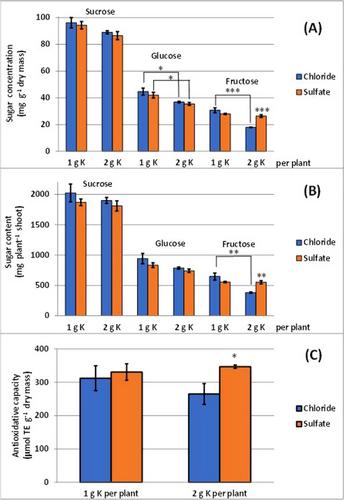Potatoes are regarded very prone to chloride toxicity, and the application of sulfate-based potassium fertilizers is therefore recommended. However, in several studies, no significant differences between KCl and K2SO4 on tuber yield and starch concentration were found. In addition, plant shoots occasionally showed more pronounced stress symptoms after sulfate compared to chloride treatment.
This study aimed to identify reasons for enhanced stress occurrence of potato plants after K2SO4 instead of KCl fertilization.
We conducted a pot experiment with the potato cultivar Marabel, which showed to be chloride-resistant in our previous study, and applied 1 g K or 2 g K either as K2SO4 or KCl. Plant shoots were analyzed for nutrients, sugars, and antioxidative capacity shortly before start of flowering (intermediate harvest), and tubers were harvested at physiological maturity and their starch concentration and yield were determined.
With sulfate-based K fertilization, the start of flowering and ripening as well as the achievement of physiological maturity occurred earlier than with KCl supply. However, the accelerated development of K2SO4-treated plants did not affect shoot fresh and dry mass shortly before flowering and at maturity, showing similar values as in the KCl treatment. With 2 g K as K2SO4, the potato plants produced much larger and less than half the number of tubers compared to 2 g K as KCl, resulting in a significantly reduced tuber fresh mass. Tuber starch concentration as well as starch yield per plant were not significantly affected by the kind of K fertilization. In plant shoots shortly before flowering, calcium and magnesium concentrations were significantly decreased, combined with a significant increase in antioxidative capacity after application of 2 g K as K2SO4 compared to KCl. Sugar concentrations and contents in potato shoots at flowering were mostly unaffected by the kind of K fertilizer.
Stronger toxicity symptoms and growth inhibition after sulfate compared to chloride application, combined with a significant increase in antioxidative capacity, provide evidence for sulfate-induced oxidative stress. A higher production of organic anions such as succinate may be involved in the stress reaction. This needs to be investigated in more detail in further studies.


